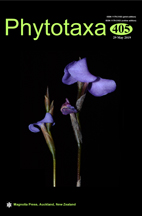Abstract
Polystachya danielana, a new species from Kenya based on evidence from morphology and molecular phylogenetics is described and illustrated here. It is closely related to P. spatella and P. kermesina, but distinguished from these two species mainly by its pseudobulbs mostly arising from the nodes near the base of the previous growth with only a few from the middle or upper nodes, leaves narrowly oblong or narrowly obovate-lanceolate, 2–8 × 1–2 cm, bracts oblong, ca. 4 × 3 mm, apex emarginate with a caudate tip, ovary purple, dorsal sepal subovate, 5.0–7.0 × 3.0–4.5 mm, column ca. 2 mm long. Its position in P. sect. Superpositae is discussed.

